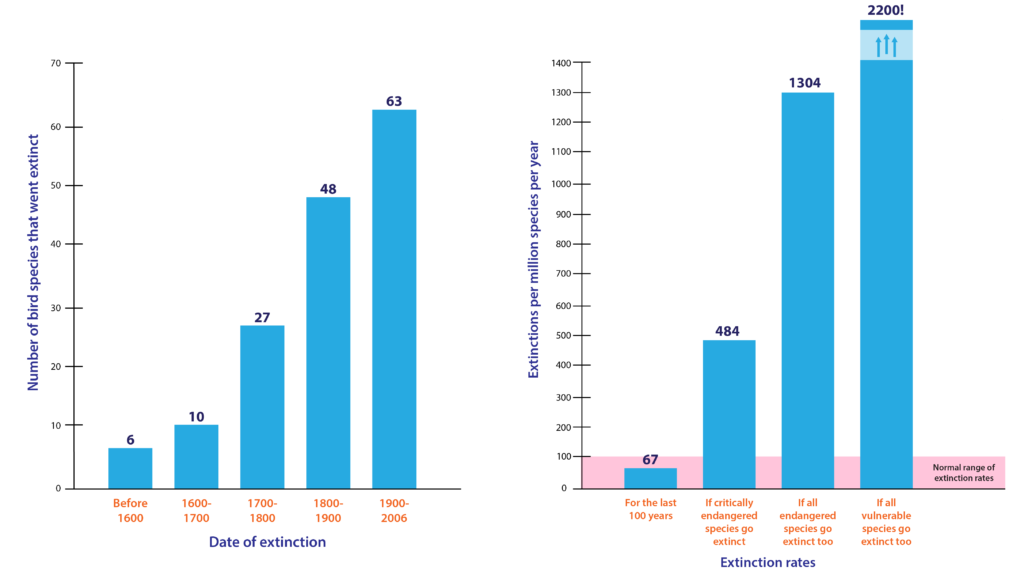As human populations have grown and become more technologically advanced, we’ve taken a larger toll on the rest of the natural world. We’ve encroached on (and sometimes wiped out) the habitats of other species; we’ve released pollutants into the air, soil, fresh water, and oceans; and we’ve even changed the atmosphere and climate. These changes are disrupting Earth’s systems at global scales — and are occurring rapidly. Because of our burning of fossil fuels, carbon dioxide levels are rising faster than they ever have at any point in Earth’s history.10 It’s no surprise then that extinction rates have risen drastically in the last 500 years.

In this module, we’ve seen that mass extinctions involve a sharp increase in extinction rates. So how bad is our current situation? Have humans pushed the Earth into its sixth mass extinction? Evidence suggests that we are well on our way to that outcome, if not in a mass extinction already. We are currently losing species hundreds or thousands of times faster than normal background extinction rates. If this continues, Earth’s biodiversity will plummet.13
The good news is that there are still opportunities to dampen our impact and protect many of Earth’s remaining species. Previous mass extinctions have been caused by factors entirely out of our control: asteroid impacts, volcanic activity, and the like. But the current extinction rate is being pushed ever higher by human activity — and that means that human activity can also reverse this trend, although it will require significant efforts on many fronts. We can reduce the extinction rate through policy changes that, for example, increase conservation efforts, change our patterns of land use, and curb our production of greenhouse gases to slow climate change. However, we must act quickly: the window for such changes to make a difference is closing. Studies of the Earth’s history may also play an important role in this effort. If we can understand the chain of events that led to past mass extinctions, we will be in a better position to break that chain today. And if we can understand what traits make a species particularly vulnerable during a mass extinction, we may be able to better focus our conservation efforts. Investigating Earth’s past extinctions may be one of the keys to preserving biodiversity for the future.
Want to learn more about how climate change affects life on Earth? Check out the following Understanding Evolution resources:
- Warming to evolution, a news brief on evolutionary responses to climate
- Ancient fossils and modern climate change: The work of Jennifer McElwain, a research profile about how studying past climate change and extinction can help us understand the changes going on around us today
Visit the Understanding Global Change site to learn more about:
10Kiehl, J. 2011. Lessons from Earth's past. Science 331:158-159.
11Pimm, S., Raven, P., Peterson, A., Şekercioğlu, Ç. Ehrlich, P.R. (2006). Human impacts on the rates of recent, present, and future bird extinctions. Proceedings of the National Academy of Sciences USA. 103: 10941-10946.
12Barnosky, A.D., N. Matzke, S. Tomiya, G.O.U. Wogan, B. Swartz, T.B. Quental,...and E.A. Ferrer. 2011. Has the Earth's sixth mass extinction already arrived? Nature 471:51-57.
13Ceballos, G., Ehrlich, P. R., Barnosky, A. D., García, A., Pringle, R. M., and T. M. Palmer (2015). Accelerated modern human–induced species losses: Entering the sixth mass extinction. Science Advances 1: e1400253.
Ceballos, G., Ehrlich, P. R., and P. H. Raven (2020). Vertebrates on the brink as indicators of biological annihilation and the sixth mass extinction. Proceedings of the National Academy of Sciences 117: 13596–13602.
